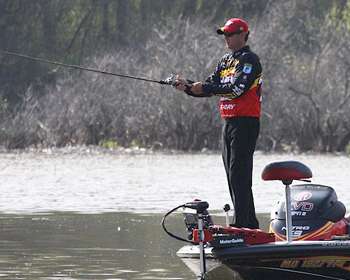
Watching Kevin VanDam fish during the postspawn and summer months on lakes like Kentucky and Guntersville, it would appear to the untrained eye that the Michigan pro is lost, helplessly flailing at open water. However, that's hardly the case.
While his boat may be bobbing hundreds of yards from the nearest bank, VanDam is often making precision casts to underwater humps holding schools of bass. With a basic knowledge of electronics, it's not difficult to find offshore humps.
That being said, catching bass off them can be quite a chore. For VanDam, the No. 1 factor in locating bass on humps is current. "When I'm fishing a hump, the main thing I want to know is if there's current," he says. "Current can be created by a river system, dam generation or wind. Whether it's a hump on Lake Erie or a hump on Kentucky Lake, there's usually going to be some type of current on it. That's the key factor in positioning the bass," explains VanDam.
When there's strong current, the bass typically move toward the top of the hump in shallow water to feed on passing schools of baitfish. "With current, you're more likely to find bass located closer to the front edge of the hump on the side where the current is coming in," he explains.
"The bass know when it's conducive for them to feed, and that current creates ambush points on the hump where the bass will lie in wait." Shellbeds, rockpiles and depressions are ideal ambush points for bass on humps, and VanDam says it's critical to identify these key areas on each hump in order to effectively fish the area.
These key spots can be found several ways, including searching with sonar and by actually feeling them with a lure. "It's very important to look around a hump with your electronics," explains the three-time Bassmaster Classic champion. "By using [Humminbird's] Side Imaging and Down Imaging, you can actually see a big rock or little rockpiles that are going to help position the bass." If you don't have access to high-end electronics, it's also possible, though more time-consuming, to find sweet spots by casting a heavy bait across the hump.
"Casting a Carolina rig with a heavy weight or a 1-ounce football jig will allow you to feel where the hard places are on the bottom," says VanDam. With some experience, it's also possible to use a deep diving crankbait to quickly comb the top of a hump and identify key areas. Using his Quantum Signature Series composite cranking rod matched with fluorocarbon line, VanDam says that it is possible to feel hard areas on the bottom.
"The composite rod with fluorocarbon line really improves sensitivity. With practice, you can learn a lot about what's out there." When faced with slack current, VanDam allows that catching fish on offshore humps becomes challenging, but there are some tricks to put some bass in the boat. "If there's no current at all, or very little current, the bass will typically scatter all around the hump and suspend. It usually makes them harder to catch," he says.
With inactive fish, it all comes down to triggering a bite. If he has located an irregularity on the hump where he believes a bass is sitting, VanDam will make multiple casts to entice a strike. "Sometimes when there's little current, it may take 10 casts in the same spot to generate a strike," he explains. "Often, that first fish will ignite the whole school." VanDam offers this final piece of advice for anglers plying offshore humps:
"Once you catch a fish, take a close look at where you caught it and try to duplicate that cast over and over."
(Provided by Z3 Media)




